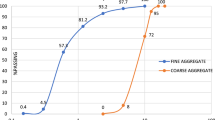Abstract
The incorporation of Supplementary Cementitious Materials (SCMs) greatly influences the pore structure and rheological properties of High Performance Concrete (HPC). Rheology affects the behaviour of hardened concrete and pore structure can give insight into the microstructure of the concrete and its performance in terms of both strength and durability. Hence, modification of rheology which is possible to control at the time of production can be extremely helpful in enhancing the performance of concrete. In this paper, an attempt has been made to link rheology with pore structure of HPC. The approach will provide better understanding and controlling of HPC and will give impetus to utilize SCMs in the production of HPC. The use of SCMs conserve energy and saves the use of cement which results in reduction of emission of carbon dioxide in the atmosphere. SCMs such as Fly Ash (FA) and Silica Fume (SF) were incorporated as partial cement replacements for the preparation of binary and ternary blended systems. The pore structure of hardened blended systems study was conducted using MIP and rheology such as plastic viscosity and yield stress using the two-point test. It was observed that the incorporation of SF decreased the plastic viscosity of concrete as compared to the reference mix whilst the FA content increased the plastic viscosity and a reasonable relationship exists between plastic viscosity and yield stress. The ternary systems reduced volume of large pores as compared to the reference mix. There exists a reasonable relationship between rheology of fresh concrete and pore structure of hardened concrete.
Similar content being viewed by others
References
Banfill, P. F. G. (2011). “Additivity effects in the rheology of fresh concrete containing water-reducing admixtures.” Construction and Building Materials, Vol. 25, No. 6, pp. 2955–2960, DOI: 10.1016/j.conbuildmat. 2010.12.001.
Brakel, J., Modry, S., and Savata, M. (1981). “Mercury porosimetry: state of the art.” Powder Technology, Vol. 29, pp. 1–12, DOI: 10.1016/0032-5910(81)85001-2.
Flatt, R. and Schober, I. (2012). “Superplasticizers and the rheology of concrete, understanding the rheology of concrete.” A volume in Woodhead Publishing Series in Civil and Structural Engineering, pp. 144–208, DOI: 10.1533/9780857095282.2.144.
Ghoddousi, P., Javid, A. A. S., and Sobhani, J. (2014). “Effects of particle packing density on the stability and rheology of self-consolidating concrete containing mineral admixtures.” Construction and Building Materials, Vol. 53, No. 28, pp. 102–109, DOI: 10.1016/j.conbuildmat. 2013.11.076.
Hearn, N. and Hooton, R. D. (1992). “Sample mass and dimension effects on mercury intrusion porosimetry results.” Cement and Concrete Research, Vol. 22, No. 5, pp. 970–980, DOI: 10.1016/0008-8846(92)90121-B.
Juenger, M. C. G. and Siddique, R. (2015). “Recent advances in understanding the role of supplementary cementitious materials in concrete.” Cement and Concrete Research, Vol. 78, pp. 71–80, DOI: 10.1016/j.cemconres.2015.03.018.
Khan, M. I. (2003). “Permeation of high performance concrete.” Journal of Materials in Civil Engineering, ASCE, Vol. 15, pp. 84–92, DOI: 10.1061/(ASCE)0899-1561(2003)15:1(84).
Manmohan, D. and Mehta, P. K. (1980), “Pore size distribution and permeability of hardened cement pastes.” Proc., Seventh International Congress of Chemistry of Cement, Paris, Vol. 3, pp. 1–5.
Neville, A. M. (1995). Properties of Concrete, Fourth edition, Longman, England.
Siddique, R. and Khan, M. I. (2011). Supplementary cementing materials, Springer-Verlag, Germany, DOI: 10.1007/978-3-642-17-866-5.
Tattersall, G. H. (2003). Workability and quality control of concrete, E & EN Spon, Chapman and Hall, London. https://books.google.com.sa/books?isbn=0203473140.
Wallevik, O. H. and Wallevik, J. E. (2011). “Rheology as a tool in concrete science: The use of rheographs and workability boxes.” Cement and Concrete Research, Vol. 41, No. 12, pp. 1279–1288, DOI: 10.1016/j.cemconres.2011.01.009.
Watanabe, A., Takayama, S. and Khin, M. Y. O. (1981) “Study on the workability of high strength concrete containing superplasticizer.” Proc., Third International Congress on Polymers in Concrete, Japan, Vol. 2, pp. 1344–1354. http://trid.trb.org/view.aspx?id=205119#.
Yanagati, K. and Wami, H. (1993). “Evaluating the flow properties of high strength concrete.” Proc., Symposium on Utilization of High Strength Concrete, Lillehammer, Norway, pp. 988–998. http://trove.nla.gov.au/version/29116107.
Author information
Authors and Affiliations
Corresponding author
Rights and permissions
About this article
Cite this article
Iqbal Khan, M., Mourad, S.M. & Charif, A. Utilization of Supplementary Cementitious Materials in HPC: From rheology to pore structure. KSCE J Civ Eng 21, 889–899 (2017). https://doi.org/10.1007/s12205-016-1781-x
Received:
Accepted:
Published:
Issue Date:
DOI: https://doi.org/10.1007/s12205-016-1781-x




